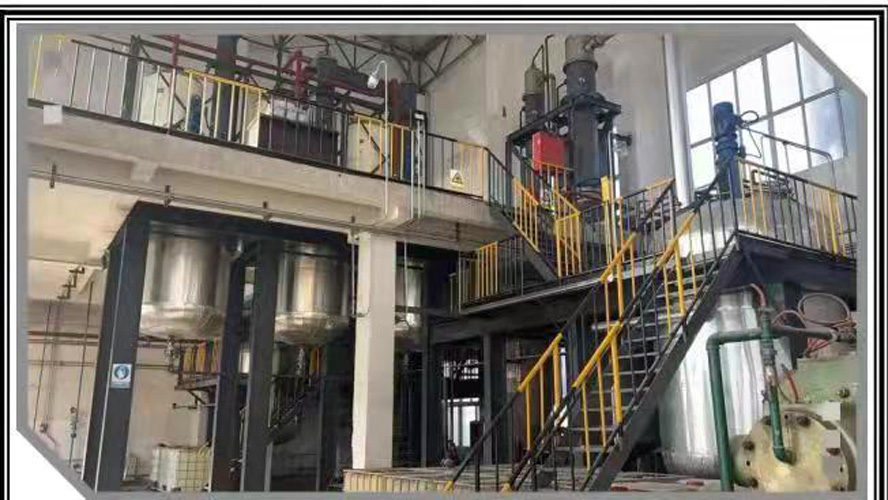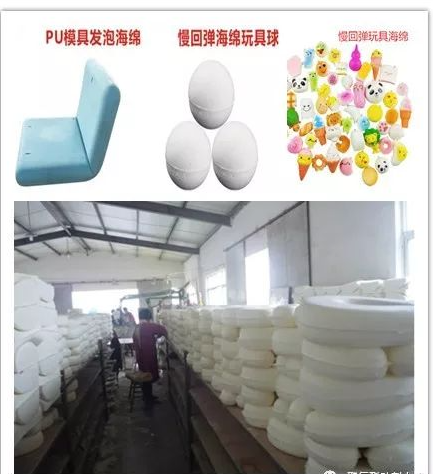Slow rebound sponge recipe for the use of small and medium materials
Slow rebound sponge and ordinary cotton formula is similar. In addition to the main material polyether has a large difference, certain small materials can be used interchangeably. But in order to produce high-quality products, the choice of small materials or should be carefully selected.

A, the choice of amine
The most classic amine for slow rebound sponge, the first American air company’s Dabco33-LV. its dosage is generally 0.3-0.8 of the total amount of polyether. It is formulated with 33% triethylenediamine and 67% dipropylene glycol (DPG). The reason why this product is recommended is that it uses a solvent of mono-dipropylene glycol. One may ask, is one solvent so important? The answer is yes. From the ability to dissolve triethylenediamine, there are many other alcohols that can be used as solvents: for example, propylene glycol, diethylene glycol, ethylene glycol, 1.4-butanediol, etc. However, among these small molecule alcohols, only monodipropylene glycol has the highest molecular weight and the lowest hydroxyl value. As we all know, small molecular weight alcohols can be used as chain extenders or cross-linking agents, which means that these small molecular alcohols can consume TDI, and the result is: on the one hand, it reduces the TDI index, and on the other hand, it is easy to cause sponge closure.
Before 2012, only a few countries in the world could produce DPG with 99% or more purity, and only one factory in Anhui Province could produce DPG with 95% purity, which is a few percentage points different from the purity of DPG. As a result, the most available amines in the domestic market are those formulated with ethylene glycol as the solvent. Some catalyst manufacturers, in order to pursue profits, deliberately reduce the concentration of triethylenediamine, with such amine foaming, to ensure the catalytic capacity, it is inevitable to increase the amount of catalyst, this catalyst containing a large number of small molecules solvent, will consume too much TDI, if the amount of TDI is not adjusted, the sponge will become soft, the tendency to increase the closed pore. In addition, the slow rebound tension and tear strength issued by this amine are not good.
I believe that with the progress of domestic chemical separation engineering technology, more and more high purity DPG will be introduced, and more and more domestic Dabco33-LV will be available. Of course, some other amines can also be issued slow rebound, such as 9727, CS90, etc., but before using must do a rigorous small test, production to consider the amplification effect. It is not recommended to use SMP to send slow rebound. In the winter foaming difficulties, you can add 0.1-0.3 parts of A1 catalyst to strengthen the foaming reaction.

Second, the choice of tin
The master who has sent ordinary sheep like to use tin octanoate (T-9) to send a slow rebound, but I recommend using dibutyltin laurate (D22, T-12, also known as K-19). Stannous octanoate is suitable for hair medium and low density sponge. It is characterized by fast viscosity in the early stage, but the latter is not strong enough. T-9 is easy to hydrolyze, slow rebound itself is slow to start (generally control the starting time in about 160 seconds), its contact time with water is long, there will be part of the hydrolysis off, affecting the maturation. Dibutyltin dilaurate is not hydrolyzed, hair, gel, smooth maturation, good post maturation.
Once some peers said that the sponge pulling force is not good, I suggest using dibutyltin laurate, the feedback is that the pulling force has improved. If you use T-9, the dosage is 0.1-0.4 parts. If you use dibutyltin laurate, the dosage can be controlled between 0.03-0.05. In the case of in-line slow rebound, the dosage can be reduced to 0.001-0.01 parts. For export orders that restrict the use of tin catalyst, I suggest using bismuth naphthenate to replace tin on it.

Three, the choice of silicone oil
Typical slow rebound silicone oil is B8002, its dosage is between 0.5-2 copies. High-density sponge less, low-density sponge with more points. Manual bubble more, machine hair less. In recent years, domestic silicone oil suppliers have developed a number of silicone oil for slow rebound, performance is also good. Also useful L-580 hair slow rebound, when the amount of silicone oil to reduce, after all, the activity of L-580 is relatively high.
Fourth, the choice of opening agent
The history, status, performance, application of the opening agent, has been briefly described in the previous articles, here will not be repeated.
Fifth, slow rebound sponge also used in flame retardant, because there are not many such a single, here we will not discuss.
Six, the use of pigment and ordinary cotton basically the same, also skipped. Just encounter black sheep to pay attention to, because the preparation of black color paste of carbon black has hydrophobic, will affect the compatibility of the various components of the formula and the efficiency of the catalyst, many colleagues have encountered black sheep easy to crack the phenomenon, the reason is here. Therefore, the amount of catalyst should be adjusted appropriately when the black color is developed. Personal work experience, for reference only, colleagues are welcome to criticize the correction.
Translated with www.DeepL.com/Translator (free version)

